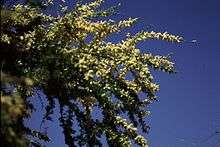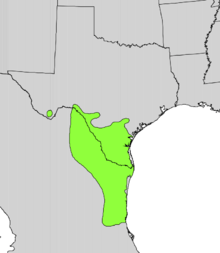Vachellia rigidula
Vachellia rigidula, commonly known as blackbrush acacia or chaparro prieto, and also known as Acacia rigidula, is a species of shrub or small tree in the legume family, Fabaceae. Its native range stretches from Texas in the United States south to central Mexico.[3] This perennial is not listed as being threatened.[4] It reaches a height of 5–15 feet (1.5–4.6 m).[5] Blackbrush Acacia grows on limestone hillsides and canyons.[6]
| Vachellia rigidula | |
|---|---|
 | |
| Scientific classification | |
| Kingdom: | Plantae |
| Clade: | Tracheophytes |
| Clade: | Angiosperms |
| Clade: | Eudicots |
| Clade: | Rosids |
| Order: | Fabales |
| Family: | Fabaceae |
| Clade: | Mimosoideae |
| Genus: | Vachellia |
| Species: | V. rigidula |
| Binomial name | |
| Vachellia rigidula (Benth.) Seigler & Ebinger | |
 | |
| Natural range | |
| Synonyms | |
| |
Phytochemistry
A phytochemical study of V. rigidula[7] by workers at the Texas A & M University Agricultural Research and Extension Center at Uvalde, TX, reported the presence of over forty alkaloids, including low amounts (up to around 15 ppm) of several amphetamines that had previously been found by the same research group in the related species Senegalia berlandieri,[8] but which otherwise are known only as products of laboratory synthesis. Compounds found in the highest concentrations (ranging from a few hundred to a few thousand ppm) were phenethylamine, N-methylphenethylamine, tyramine and N-methyltyramine. Other notable compounds reported were N,N-dimethyltryptamine, mescaline, amphetamine, methamphetamine and nicotine, although these were found in low concentrations (e.g. mescaline at 3-28 ppm).
The presence of such an unprecedented chemical range of psychoactive compounds, including ones not previously found in nature, in a single plant species has led to the suggestion that some of these findings may have resulted from cross-contamination or were possibly artifacts of the analytical technique.[9]
Uses
Vachellia rigidula is used in weight loss dietary supplements because of the presence of chemical compounds claimed to stimulate beta-receptors to increase lipolysis and metabolic rate and decrease appetite.[10]
Vachellia rigidula is also known as a large honey producer and early blooming plant for its native region.[5]
Safety
In 2015, 52% of supplements labeled as containing Acacia rigidula were found to be adulterated with synthetic BMPEA, an amphetamine isomer.[11] Consumers following recommended maximum daily servings would consume a maximum of 94 mg of BMPEA per day.[11] In 2012, however, the FDA determined that BMPEA was not naturally present in Acacia rigidula leaves.[12]
Gallery
 Seeds
Seeds Foliage
Foliage Bark
Bark
References
- Botanic Gardens Conservation International (BGCI) & IUCN SSC Global Tree Specialist Group 2019 (2019). "Acacia rigidula". The IUCN Red List of Threatened Species. IUCN. e.T144316027A149032431. doi:10.2305/IUCN.UK.2019-2.RLTS.T144316027A149032431.en.
- "Acacia rigidula - Benth. Blackbrush Acacia". NatureServe Explorer. NatureServe. Retrieved 2010-10-17.
- "Acacia rigidula". Germplasm Resources Information Network (GRIN). Agricultural Research Service (ARS), United States Department of Agriculture (USDA). Retrieved 2010-10-17.
- "Acacia rigidula". LegumeWeb. International Legume Database & Information Service (ILDIS). Archived from the original on June 29, 2007. Retrieved 2019-10-18.
- "Acacia rigidula Benth". Native Plant Database. Lady Bird Johnson Wildflower Center. Retrieved 2009-06-30.
- "Blackbrush Acacia, Chaparro Prieto, Catclaw, Gavia". Texas Native Plants Database. Texas A&M University. Retrieved 2009-06-30.
- Clement, Beverly A; Goff, Christina M; Forbes, T.David A (1998). "Toxic amines and alkaloids from acacia rigidula". Phytochemistry. 49 (5): 1377–80. doi:10.1016/S0031-9422(97)01022-4.
- Clement, Beverly A.; Goff, Christina M.; Forbes, T. David A. (1997). "Toxic amines and alkaloids from Acacia berlandieri". Phytochemistry. 46 (2): 249–54. doi:10.1016/S0031-9422(97)00240-9.
- "Acacias and Natural Amphetamine". Ask Dr. Shulgin Online. Center for Cognitive Liberty & Ethics. 2001-09-26.
- WO application 2006099274, Jared R. Wheat, "Dietary Supplement and Method of Using Same", published 2006-09-14
- Cohen, Pieter A.; Bloszies, Clayton; Yee, Caleb; Gerona, Roy (2015). "An amphetamine isomer whose efficacy and safety in humans has never been studied, β-methylphenylethylamine (BMPEA), is found in multiple dietary supplements". Drug Testing and Analysis. 8 (3–4): 328–33. doi:10.1002/dta.1793. PMID 25847603.
- Goodman, Brenda (2015-04-07). "Untested Stimulant Still in Dietary Supplements". WebMD.
External links
![]()
![]()

